

Six CHC recipes to try this holiday season
For many, fall and winter are traditional times when we surround ourselves with friends and loved ones over a shared meal. But life doesn’t always allow us to gather when the holiday season rolls around. Maybe your studies have taken you far from home or a new job has sparked a big move. Whatever your situation, everyone deserves the opportunity to celebrate, no matter how that looks or who you share it with.
Here are six recipes from Clark Honors College students, staff, and faculty to keep you connected to your community — whether you’re home together or thousands of miles away.
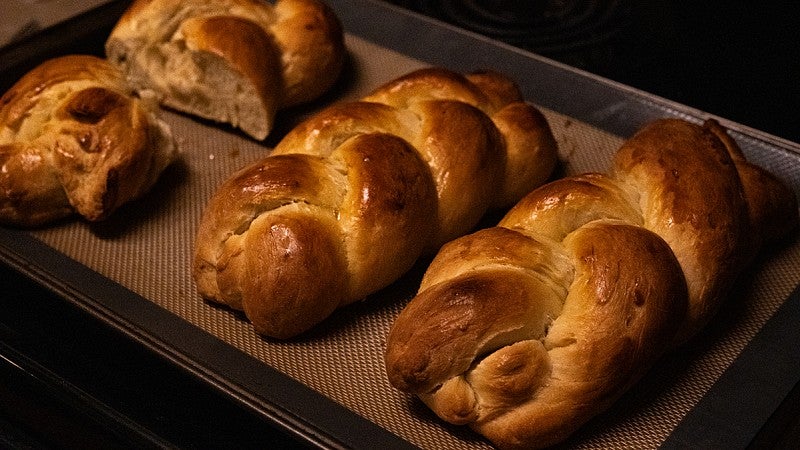
Dinner Rolls
From Hannah Landswick's Family
Why this recipe: “You can’t really go wrong. It’s dinner rolls, and it’s always been something that is very comforting.”
If you visit the Landswicks for dinner during the holidays, you can find Hannah Landswick putting up Christmas decorations in her grandma’s house as her brother and grandma make dinner. Landswick’s favorite part? Her grandma’s dinner rolls.
The recipe comes from a Shuler’s cookbook Landswick’s grandma received from her own mother in 1951. Shuler’s is a well-known restaurant in Michigan that has been around for more than 100 years. The dinner rolls recipe has been a Christmas tradition in the Landswick family for three generations now.
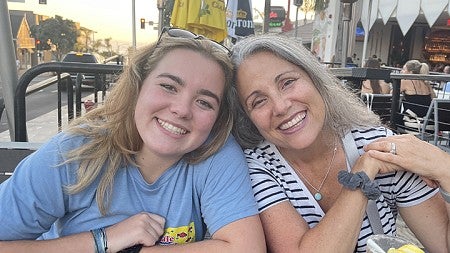
She didn’t know about the history of the dinner rolls until she talked to her mom about it recently. “It’s crazy,” she says. “It’s something that’s always been there and randomly, I’ll ask about it and there’s actually a story behind it.”
“I mean, you can’t really go wrong. It’s dinner rolls, and it’s always been something that is very comforting,” she says. She dips the rolls in gravy and mashed potatoes at Thanksgiving. During Christmas time, she’ll eat them with the brisket they serve every year.
Now in Eugene, Landswick is searching for food to remind her of home. There’s a deli in Studio City, called Art’s, that she and her family have been going to her whole life. It’s where she had her first bagel and spent time with her family growing up.
“Traditional sit-down meals are where I’ve been able to spend the most time with my family,” she says. And even though her grandma only lives fifteen minutes away from where she grew up, “life gets so busy, so it’s definitely nice to have those sit-down holiday or birthday meals.”
Today, she is more than 800 miles away from her home and family, but she’s staying connected. Calls with her parents and grandma hold her over between her visits with family.
She remembers earlier this year, when her family sent cookies from one of her favorite bakeries for Valentine’s Day.
“It’s definitely nice to have grown up in an area where the food culture is so diverse,” she says. “So, being able to have them send me little bits of back home — it’s nice.”
Hannah Landswick’s Family Dinner Rolls
Ingredients
- 8 cups flour
- 2 ½ cups lukewarm milk
- 2 yeast cakes
- 1 cup sugar
- ½ teaspoon salt
- ¾ - 1 cup melted butter
- 1 egg
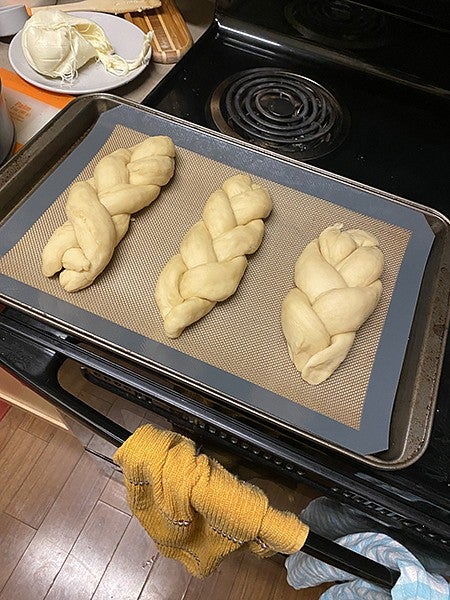
Instructions
For the rolls:
- Dissolve yeast cakes in ½ cup lukewarm milk.
- Mix remaining milk, sugar, salt, butter, and small amount of flour; beat smooth.
- Add yeast cake and milk combination, along with the remaining flour; beat with wooden spoon until smooth and firm.
- Sprinkle dough with small amount of flour, cover with clean towel and let rise in warm place until doubled in bulk, about 2 hours.
- Turn onto lightly floured baking board and knead until smooth.
To shape:
- Take half of the dough, divide it into two or three parts and cut each part into three pieces of equal size.
- Roll with hands into long ropes and braid. Place on buttered baking sheet, cover, and let rise.
- Brush with a slightly beaten egg. Sprinkle with sugar and bake in oven at 375 degrees F. for 15-20 mins. Then repeat with the other half of the dough.
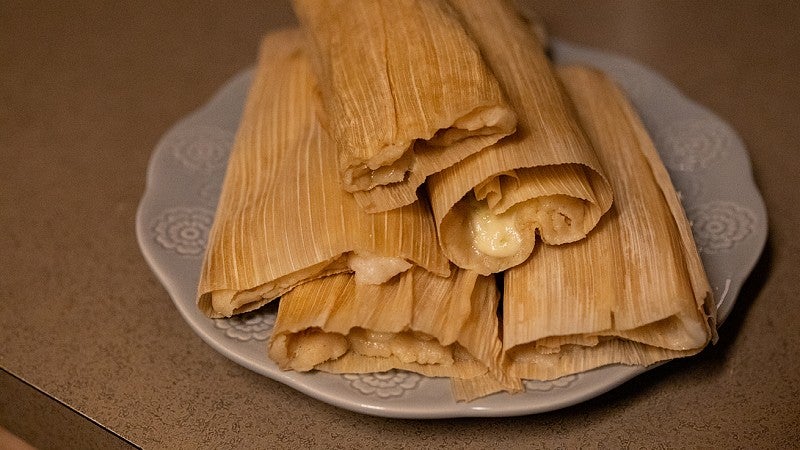
Tamales
From Erika Balbuena's Family
Why this recipe: “You would all be around each other for an extended period of time where you can really talk.”
Erika Balbuena’s parents brought her packets for making atole — a hot masa drink — during a visit. But she’d never made the drink on her own before. So, one Sunday morning, with her friends and roommates, she recreated the morning gatherings she’s had with her family. They made atole together, and Erika introduced her friends to something they’d never tried before.
“Lately, I have been feeling really disconnected from home and been missing it,” she says. “(That Sunday) helped me feel a lot better.”

Raised in Joliet, Illinois, Erika Balbuena has struggled to access the food she was accustomed to back home after coming to Eugene for college. Now in her sophomore year, she makes an effort to recreate the dishes she grew up on in a new environment — and share them with her newfound community.
Freshman year didn’t provide many opportunities for connecting to home with food — especially without a reliable means of transportation or a kitchen of her own. Now, Balbuena is challenging herself to start cooking some of the dishes she loves.
Her mom shared her classic rice recipe that she’s been using as a base for many of her meals. She’s been bringing her roommates who don’t share her Hispanic culture in on the adventure of cooking new meals together and sharing the food.
“I am not a cook whatsoever, so there’s been some trials and some triumphs,” Balbuena says. Her next goal in the kitchen is to make chilaquiles — she was missing the specific brand of tortilla chips that she eats at home, so her parents brought her some when she moved in earlier in the fall.
Having her own car has been another important resource in accessing familiar food. She’s made an effort to track down local panaderias, and trying out the bolillos and other pastries. She often visits with her roommates. She doesn’t have a favorite spot yet, she says, as each location has a specialty of its own.
“And there’s still other ones that I have yet to hit,” Balbuena says, “but it’s also really surprising to see how many there actually were.”
In addition to being able to drive to find ingredients and get baked goods, she also has an easier time cooking in her own kitchen and having all of the tools she needs for her food.
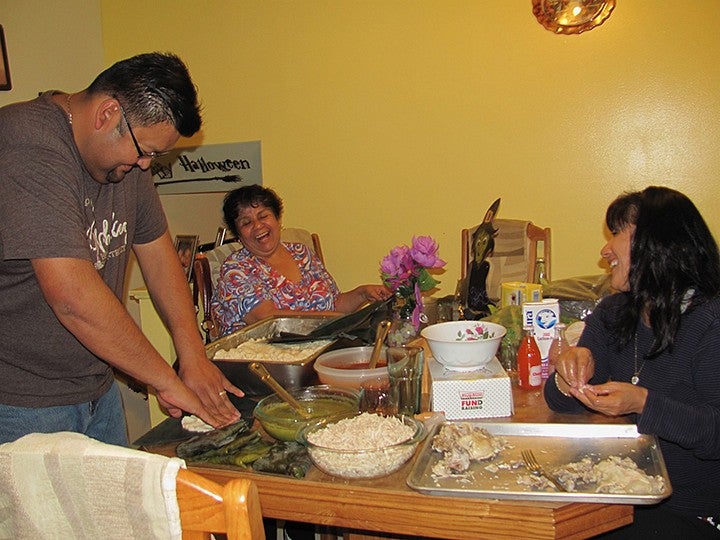
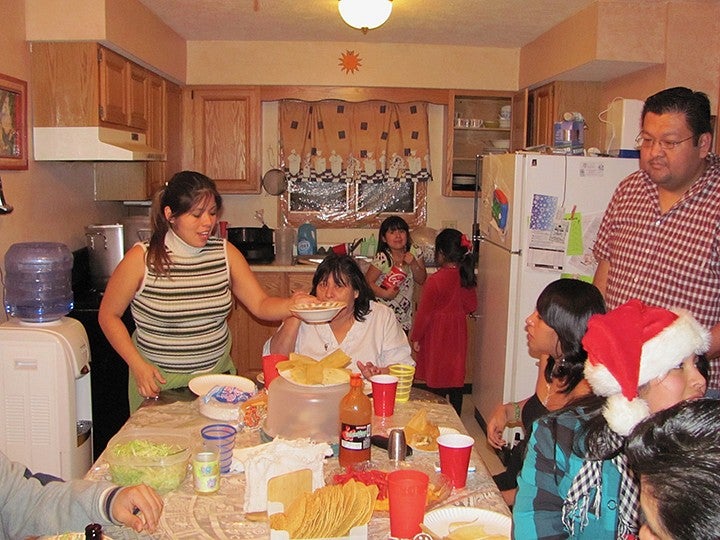
Another goal while she’s here in Eugene is making tamales. The Balbuena family is close-knit and large, so they would always meet up for birthdays, holidays, and just regular family gatherings. They would gather around the kitchen or dining table, cooking, eating, and talking together.
“You would all be around each other for an extended period of time where you can really talk,” she says about the process of preparing tamales. Recently, her uncle got engaged and the family was excited to have his fiancé join in on the tamale-making for their first time.
“Just like most people believe, food brings people together,” she says, “and I just think that was the same for my family.”
Erika Balbuena’s Family Tamal Recipe
Ingredients
For the dough:
- 4 cups masa harina
- 3 cups chicken broth
- 2 teaspoons baking powder
- 1 teaspoon salt
- 1 1/3 cups lard
- 8-ounce package dried corn husks
For the filling:
Depends on what you want the tamales filled with, but we would do tamales de queso (cheese), salsa verde (green salsa with chicken), rajas (peppers with cheese), or some with no filling.
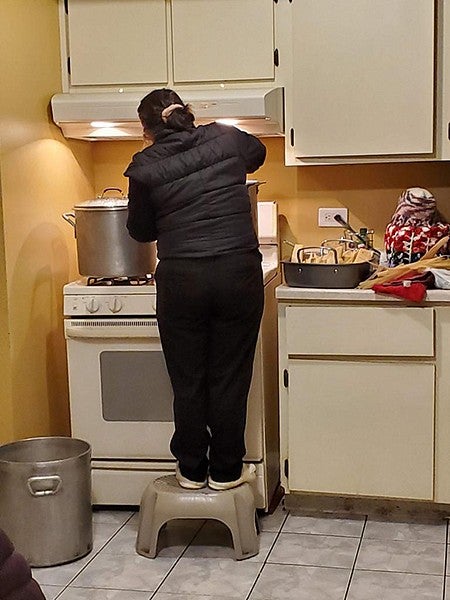

Instructions
To start, soak the corn husks in a bowl of very hot water for 30 minutes or until they are soft. Meanwhile you will make the filling of your choice.
Make tamal dough:
- In a large bowl, place the lard and mix it (play with it like dough until it becomes like liquid).
- In a separate bowl, combine the masa flour, baking powder, and salt.
- Stir that into the lard and mix well.
- Little by little, add the broth to form a very soft dough (the broth should be warm) and mix this for several minutes.
- The dough should spread like creamy peanut butter and be slightly sticky (to check for the right consistency, put a dime size of dough in a cup of water to see if it floats. If it does, it is ready).
While waiting for the corn husks to soften, cover the mixture with a damp paper towel to keep it from drying out.
Once corn husks are ready:
- Take a corn husk and spread the dough on it.
- Then take the filling of your choice and place it on top of the dough.
- Wrap the tamal from one side to the middle then the next side to the middle and bring the top (narrower side) down.
Cook on stove top:
- Add water to the bottom of the steamer and a penny. Do not fill water above the steamer rack.
- Lay a few corn husks on the bottom rack to keep the tamales from touching the boiling water directly and to keep them from falling through.
- Place tamales standing upright, open side up. Take care to pack them so they don’t slide down.
- Lay a few soaked corn husks, a plastic bag, and a wet towel over the top of the tamales before closing the lid.
- Bring water to a boil (you will hear the penny start to tap the pot once the water is boiling).
- Once it is boiling, reduce to a simmer and steam for 45 minutes to 1 hour but not longer.
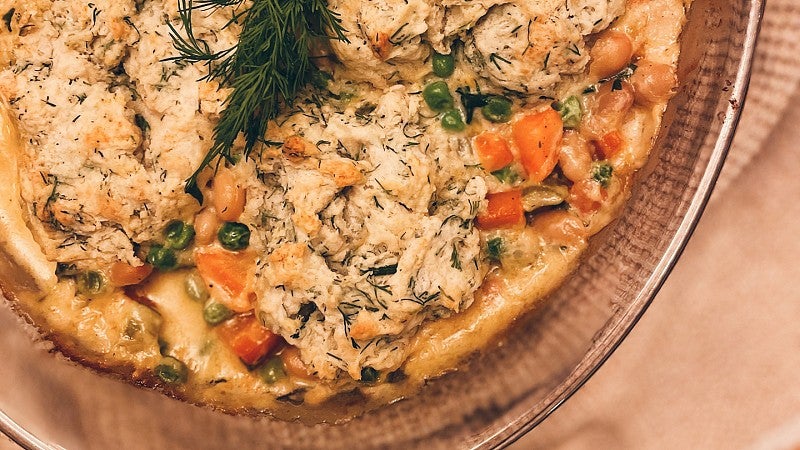
Chicken Pot Pie
From Elin England's Family
Why this recipe: She developed it when her kids were young. “Rolled crust was more than I wanted to deal with.,” England says. It was one of her children’s favorite dishes.
Elin England remembers when the local eating movement swept Lane County in the early 2000s. The concept wasn’t new to her and her husband. They had nearly nine acres of farmland where they grew everything from walnuts to table grapes.
“When you have a garden, you’re necessarily trying to eat local because you’re trying to eat everything that is coming out of the garden,” she says.
So, when a study showed it was entirely possible for Lane County to feed itself, Elin knew what it might involve. Someone, she recalls saying, would need to write a cookbook about how to cook with seasonal vegetables.
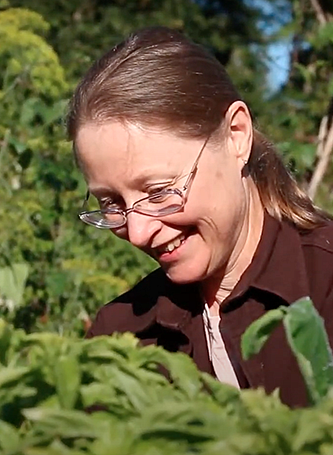
“And I was like, ‘Oh, I guess I should write a cookbook,’” she says. In fact, she wrote two, filling them with recipes about how to cook with the resources in the Pacific Northwest. She called them “Eating Close to Home: A Guide to Local Seasonal Sustenance in the Pacific Northwest” and “Beans, Grains, Nuts and Seeds: Further Adventures in Eating Close to Home.”
For England, home has been a number of places over the years. Born in New Hampshire, she spent much of her early childhood on the East Coast before moving to California because of her father’s job. But love of food remained a mainstay in her family.
Her mother and grandmother loved to cook. Her family would often spend time during one meal planning the next or reminiscing about past ones, England says. And although their move to the West Coast made it difficult to connect with family for Thanksgiving the way they had in the past, her mom made sure they were never alone.
Exchange students would often come stay with them over the holiday. England recalls a student from China teaching her mother to cook Chinese food, and a young woman from France who ate everything — including roasted chicken legs— with a fork and knife.
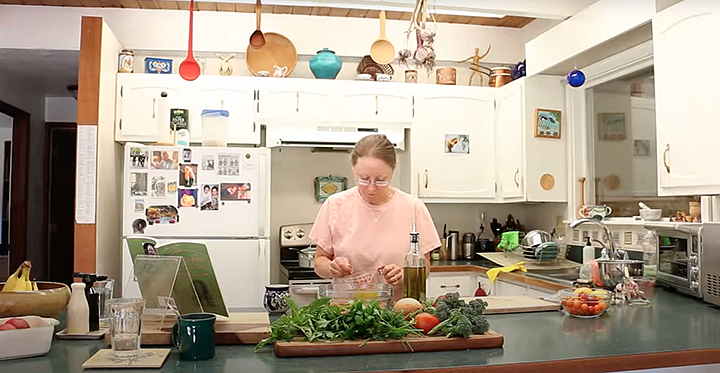
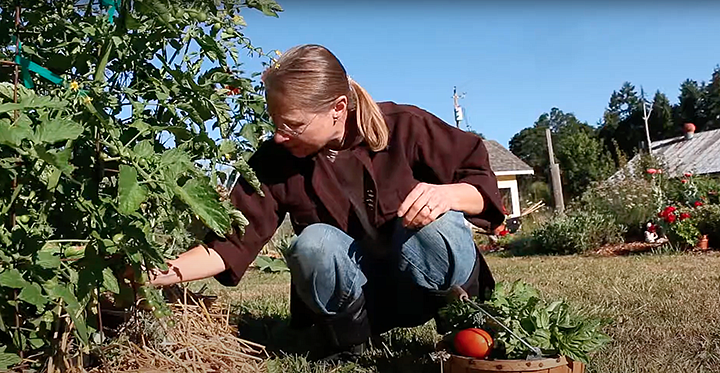
The family tradition of experimenting in the kitchen carried on into her adulthood, as England was raising her own children.
She developed her chicken pot pie recipe when her kids were young. “Rolled crust was more than I wanted to deal with,” England says. It was one of her children’s favorite dishes.
In cooking and farming alike, she’s constantly learning — and part of that process is making mistakes, she says.
“It shouldn’t be about making it perfect,” she explains. “I want people to feel like they can experiment and that if it doesn’t come out good, it’s okay, because that’s how you learn.”
Elin England's Chicken Pot Pie
Ingredients
For the filling:
- 3 tablespoons butter
- ½ cup diced celery
- ½ cup diced onion
- 1 small bay leaf
- 3 Tablespoons unbleached white flour
- 1 ½ cups chicken stock
- 1 ½ cups milk
- Dash or two of Tabasco sauce and Worcestershire sauce (optional – you can leave either or both out if you don’t have these on hand)
- Salt and pepper to taste
- 1 – 2 cups shredded or diced cooked chicken
- ¾ pound potatoes, diced and cooked
- 2-3 carrots, diced and cooked
- 4 to 6 oz frozen peas or shelled edamame
- ½ cup chopped parsley
Biscuit dough:
- 1 cup unbleached white flour
- 1 ½ teaspoons baking powder
- ¼ teaspoon salt
- 3 Tablespoons cold butter
- ½ cup milk
- 3 Tablespoons chopped dill (fresh dill is great, but dried dill will do just fine)
Notes
- To make this recipe vegetarian, substitute 1 can of drained and rinsed Great Northern beans and use vegetable stock instead of chicken stock.
- To fancy it up, add some sauteed mushrooms; chopped canned or frozen artichoke hearts; or cooked and cubed sweet potato or winter squash.
- For a speedy meal, use frozen, cooked vegetables.
Instructions
For the filling:
You will need to cook the potatoes, peas, carrots and chicken separately – you can prep these ingredients the day before or in the morning and then refrigerate until you are ready to put the dish together for supper.
In a large saucepan, melt the butter over low heat. Add the celery, onion, and bay leaf. Cover and cook until the vegetables are soft. Sprinkle the flour over the vegetables. Stir well and cook for 5 minutes. Stir in the stock and milk. Cook, stirring occasionally, until the sauce thickens, about 15 minutes. Remove the bay leaf, add the Tabasco and Worcestershire if using, and season with salt and pepper to taste. Stir in the cooked chicken, potatoes, carrots, peas and parsley. Keep warm while you make the biscuit dough:
For the pastry:
Sift the flour, baking powder and salt together in a bowl (or just stir the ingredients together very well with a whisk or a fork). Cut the butter into the flour mixture using a knife or a pastry blender. Work until the chunks are the size of peas. Add the milk and the dill and stir for a minute until the dough leaves the sides of the bowl. It will be a bit sticky.
Now put together your dish. Preheat the oven to 425F. Transfer the filling to a 3-quart oven-proof casserole dish. Drop large spoonfuls of the dough across the surface of the filling, spacing it evenly to make about 6 biscuits.
Bake for about 25 minutes, until the biscuits are lightly browned and the pie is bubbling. Serve hot.
Still hungry? Dig into three more treasured recipes from CHC's core faculty members...
Jesse Feddersen's Life-Changing Kale Salad

“I make this kale salad from Joshua McFadden's 'Six Seasons' multiple times a week. People who don't like salad like this. I use panko, a lot more garlic, and freshly grated, actual Italian pecorino romano cheese is the most important ingredient.”
Ulrick Casimir's Go-To Coconut Curry

“I’ve got lots of recipes but this one is a go-to lately. I sub in different curry pastes (I’ve made it with red and Massaman curry pastes, and both rocked my world), add a little lime juice and maybe go a bit light on the brown sugar… but that’s all to taste.”
Lisa Wolverton's Must-Have Sweet Potatoes

Ian McNeely says: “My wife (Lisa Wolverton, also CHC faculty-in-residence) has been making this cider and ginger sweet potato puree from 'Bon Appetit' for 20 years, and it’s easily the most requested dish we serve to guests.”
